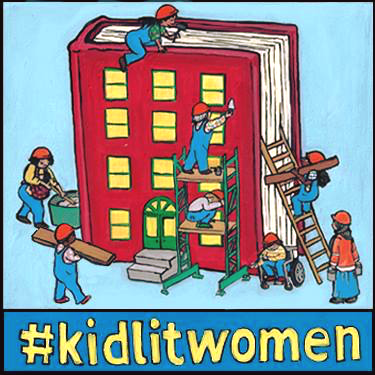
Where the Women Are: Tough Questions About the Gender Disparities in Children’s Publishing
We’re celebrating Women’s History month with 31 days of posts focused on improving the climate for social and gender equality in the children’s and teens’ literature community. Join in the conversation on Facebook https://www.facebook.com/kidlitwomen or Twitter #kidlitwomen
 Recently a group of children’s lit colleagues and I (all women) did some head-scratching about our industry’s gender disconnect. We puzzled over the fact that the majority of people in positions of power – those who publish, buy, sell, review or advocate for children’s books — are female, yet the majority of the best-known, best-selling, award-winning, and in-demand authors are male.
Recently a group of children’s lit colleagues and I (all women) did some head-scratching about our industry’s gender disconnect. We puzzled over the fact that the majority of people in positions of power – those who publish, buy, sell, review or advocate for children’s books — are female, yet the majority of the best-known, best-selling, award-winning, and in-demand authors are male.
A quick review of some statistics:
- 78% of children’s book editors and/or publishing industry staff members are women, though that number drops to 59% at the executive/board level (according to a survey by Lee & Low)
- 85% of literary agents that represent children’s and/or YA books are women (according to querytracker.net)
- 75% of school teachers are women; at the pre-school/kindergarten level that number jumps to 97.5% (according to the National Center for Education Statistics)
- 82% of librarians are women (according to the ALA), and the vast majority of children’s lit reviewers are librarians (I couldn’t find stats on this, but a search of submission guidelines and reviewer lists for School Library Journal, Kirkus, Booklist and PW confirms it anecdotally)
- 57% of children’s book buyers are women (according to Nielsen’s US Children’s Book Landscape report)
- 14 of the 15 members of the 2018 Newbery Award committee were women. 13 of the 15 members of the 2018 Caldecott committee were women (From ALA)
Because my conversation partners and I all run children’s lit education programs — some online, some bricks and mortar — we also discussed the fact that the majority of people who aspire to write for children, study children’s book writing and/or participate in workshops and conferences specific to children’s literature are women. The statistics below are from the programs that I direct, but the numbers correspond fairly closely to my colleagues’ programs, and likely to others:
- 87% of the applicants to, and participants in, Stony Brook Southampton’s annual Children’s Lit Conference are women
- Since the inception of our Children’s Lit Fellows graduate certificate program in 2013, 89% of applicants and participants have been women
- With respect to our faculty, 63% of our conference workshop leaders, and 90% of our Fellows faculty mentors, are women
Yet as we are all aware, (and as has been published by VIDA in annual studies), relative to the aforementioned ratios, women are consistently under-represented and under-recognized in children’s publishing with respect to reviews, awards, bestseller lists and invitations to speak or present at events and conferences. Somehow, as the pool of largely female aspirants moves toward publication and beyond, the male minority navigates to the top.
Given the numbers, it’s clear we can’t only blame men for the disparity. So, what’s going on?
My colleagues and I took a stab at a few possible theories, some more plausible than others. Most were sweeping (not to mention sexist) generalizations. A few made us laugh, but one or two made us squirm a little. Here are a few, in no particular order:
- Men may be better at asserting themselves (pitching, negotiating, etc.)
- Men might be more in touch with (or more willing to express) their “inner child” — hence their writing is fresher, funnier, more “kid-friendly”
- Men may have more time — or are more willing to make time — for the “business” of publishing. Women may be more conflicted about taking time away from family, household or other obligations to do the necessary networking, pitching and self-promotion
- Women in power might prefer to “have lunch” with men (this of course extends beyond lunch, to encompass working partnerships)
- Women may be innately competitive with one another, but not so much with men
- Women might instinctively favor working with men for primal reasons (men protect the cave)
- Many powerful women have made difficult choices with respect to the balance of career and family, and may hold resentment towards, or have trouble relating to, those with different priorities
- Girls will read books with male protagonists, but not so much the other way around. And if a boy is “caught reading,” he’d rather be reading a book written by a guy. This would seem to give a marketing edge to men — and/or women who write under a pseudonym and/or use only initials.
Like I said, wildly sexist generalizations… some perhaps even silly. And certainly not a comprehensive list. But even if just one of these theories has any truth to it, what is to be done about it?
It seems excessive to suggest that we all use initials or any other tactic to mask our gender when submitting a manuscript (though my colleagues and I did spend some time traveling down that theoretical road.) Even if it worked on an individual basis, it wouldn’t do much to upend the overall disconnect, beyond further proving that it exists.
The larger and more troubling question is the degree to which women may favor working with men for deep, maybe even subconscious, psychological reasons… reasons that are difficult to admit to, let alone change.
Those of us who work in children’s publishing, whether we write, illustrate, or put books into the hands of our intended audience, must by necessity remain in touch with the feelings and concerns of our young readers. Looking back on my own school days, I remember gravitating mostly toward “guy” friends — probably due to my feelings of inadequacy and trust issues with other girls. I am happy to say that these many decades later I have a strong sisterhood of girlfriends… but old wounds can feed a subconscious bias if one isn’t vigilantly honest with oneself.
Thankfully, women in our industry are beginning to band together to bring greater awareness to our work, to shine a light on the discrepancies and disconnects that have been so pervasive. But as we attempt to make our voices heard, many of us feel conflicted about putting ourselves “out there” in today’s reactionary culture. What if I appear bitchy, whiney, shrill, bossy, angry? What if I get slammed for my ideas? Will it affect my publishing prospects? My social life? My self-esteem? I’ve seen all these fears and more expressed, and I share them.
Yet in order to take the steps, both individually and as a community, toward any lasting change, we must feel safe enough to express our feelings, opinions and ideas… or numb enough not to care about the reaction. To me, the latter runs counter to the essence of womanhood, so I’ll take the gamble and share a few ideas for possible ways forward:
- Uncomfortable though it may be, we women must ask ourselves hard questions about how we may have inadvertently contributed to our situation. Let’s do some serious soul-searching with respect to our own past relationships with, behavior around, and feelings about other women, and ourselves… with an eye toward letting go of the “mean girls” that we once knew, or once were.
- Women in positions of power should actively seek ways to support and advocate for other women, in the workplace and beyond. Let’s look at our client lists, committees, datebooks and more, with a keener eye — and make some adjustments where needed.
- All women should have each other’s backs more. Let’s think twice before we attack someone for opinions that differ from ours, especially on social media. Let’s create safer spaces to take risks by asking more questions, and making fewer judgments, as a means of better understanding each other.
- And then… let’s try to do the same with men. Let’s spend some time trying to understand where they — especially those who behave badly — are coming from, what the roots of their behavior may be. Let’s explore how to have a constructive dialogue around that, with an eye towards healing the wounds that divide us right now. Let’s help men and boys find ways “to expand what it means to be a man without losing [their] masculinity,” as Michael Ian Black writes in his recent op-ed piece, “The Boys Are Not All Right.”
- Finally, let’s use our stories to spread the word. Let’s write about these issues in our books. Let’s help the next generation achieve true equality — equality that is curious about, and respectful of, our gender differences, equality that stems from mutual consciousness, care and compassion, equality that endures.

